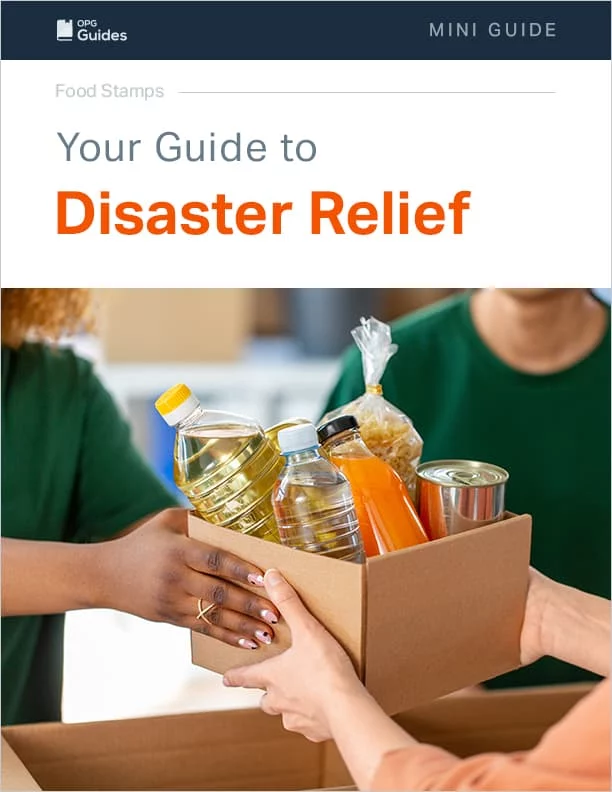Your Free Guide to Disaster Relief
Your Free Guide to Disaster Relief
The content in this guide is provided for general information only, and is not intended to address specific circumstances of any particular individuals. The content is not intended to be a substitute for professional advice.

Introduction
Disasters can strike at any time. Typically, both natural and man-made disasters can qualify for relief as long as they cause significant damage and hardship. This can include:
- Natural Disasters: Earthquakes, hurricanes, tornadoes, floods, wildfires, blizzards, and severe storms.
- Man-Made Disasters: Chemical spills, nuclear accidents, large-scale fires, and other incidents caused by human activity.
- Pandemics: Large-scale disease outbreaks, such as the COVID-19 pandemic, can also qualify for relief, given the widespread impact they can have on communities.
In these times of crisis, disaster relief becomes a necessity. This guide aims to provide an overview of the different forms of disaster relief available and how to access them.
The Basics of Disaster Relief
Disaster relief is aimed at helping people cope with the immediate aftermath of a disaster. It includes a wide range of support mechanisms depending on the nature and scale of the disaster, including:
- Financial Assistance: This can include grants to help cover costs related to the disaster, like temporary housing, home repairs, and medical expenses. Loans may also be available for businesses and homeowners to help with rebuilding.
- Material Support: This can include immediate needs like food, water, clothing, and temporary shelter.
- Medical Support: In the event of injury or illness, medical support and mental health services may be provided.
- Long-Term Support: In addition to immediate relief, support may also be provided for longer-term recovery efforts. This can include assistance with rebuilding homes and businesses, as well as community rehabilitation projects.
The goal is to help individuals and communities get back on their feet as quickly and safely as possible.
Government-Sponsored Programs
Government-sponsored programs play a crucial role in disaster relief. Agencies like the Federal Emergency Management Agency (FEMA) in the U.S. are typically at the forefront of disaster response, offering financial aid, emergency housing, and support with rebuilding efforts.
Non-Profit Organizations
Non-profit organizations often complement the work of government programs. They may offer services like medical care, psychological support, emergency food and water supplies, and long-term rebuilding assistance. Examples of these organizations include the American Red Cross, Doctors Without Borders, and The Salvation Army.
Benefits of Disaster Relief
Disaster relief helps individuals and communities recover and rebuild after a disaster. It can provide immediate material support, like food and shelter, as well as financial aid for longer-term recovery efforts. Beyond these practical benefits, disaster relief can also offer emotional and psychological support to those affected, helping them cope with the trauma and loss associated with disasters.
The Federal Emergency Management Agency (FEMA)
FEMA is the principal government agency responsible for disaster relief in the U.S. When a state’s resources are overwhelmed by a disaster, the governor can request federal assistance, leading to the deployment of FEMA resources.
Eligibility
To be eligible for FEMA assistance, you must live in a county officially declared a disaster area. You must also be a U.S. citizen, non-citizen national, or a qualified alien.
Application Process
You can apply for assistance online, by phone, or at a Disaster Recovery Center. Once your application is received, an inspector will visit to assess the damage.
How It Works
FEMA provides grants to help with disaster-related expenses, such as rent for temporary housing, home repairs, and medical or dental expenses caused by the disaster. They may also coordinate other forms of assistance, like temporary housing units and disaster unemployment assistance.
Other Forms of Disaster Relief
FEMA is not the only source of aid in a disaster. Many other resources exist, including:
- State and local government programs: Depending on the disaster, state and local governments may offer their assistance programs.
- Non-profit organizations: Charities like the Red Cross, Salvation Army, and others may provide various disaster relief services.
- Insurance: Depending on the nature of the disaster and the specifics of your policy, your insurance may cover some of your losses.
Tips for Preparing for a Disaster
While disaster relief is crucial, it’s also essential to take steps to prepare for disasters:
- Create a disaster plan: This should include evacuation routes, a designated meeting place, and a list of important contacts.
- Build an emergency kit: This should contain food, water, medical supplies, and other essentials.
- Stay informed: Monitor local news and weather updates regularly, particularly if you live in an area prone to certain disasters.
- Ensure adequate insurance coverage: Check your insurance policies to see what types of disasters are covered.
Post-Disaster Tips and Advice
After a disaster, taking steps to ensure your safety and begin the recovery process is essential. Here are some general tips:
- Ensure Safety: Make sure your immediate environment is safe. This might involve evacuating your home or moving to a temporary shelter.
- Seek Medical Attention: If you or any of your family members are injured, seek medical attention as soon as possible.
- Contact Authorities: Report your situation to local authorities. They can provide information on available resources and what steps to take next.
- Document Damage: If it’s safe to do so, document the damage for insurance purposes. Take photos and make a list of damaged items.
- Apply for Aid: Contact disaster relief organizations and apply for aid. The sooner you apply, the sooner you can receive assistance.
Conclusion
Disasters can be devastating, but you can navigate the aftermath more effectively with the correct information and resources. This guide has provided an overview of the types of disaster relief available and how to access them. However, remember that each disaster and its impact is unique, and the best course of action may vary depending on your situation. Stay safe, and don’t hesitate to seek help when needed.






